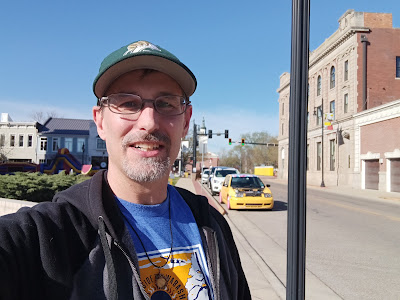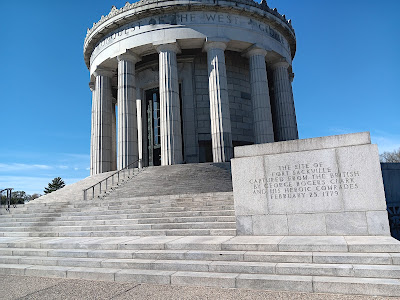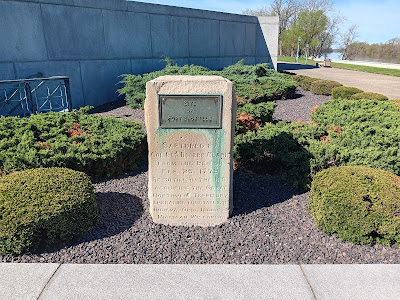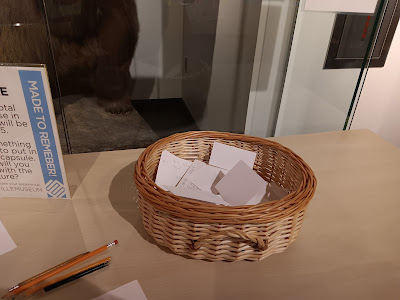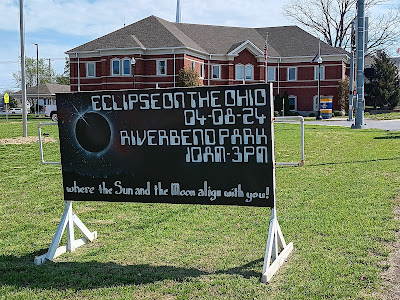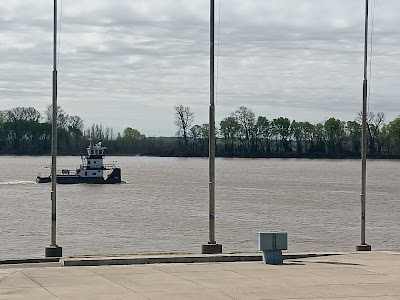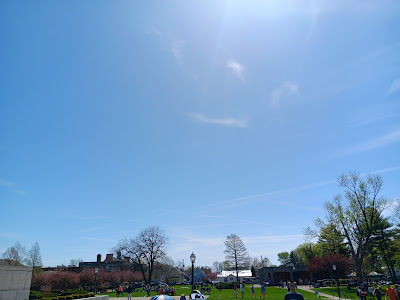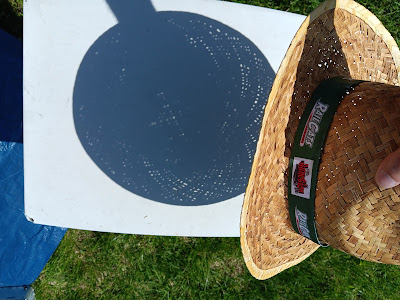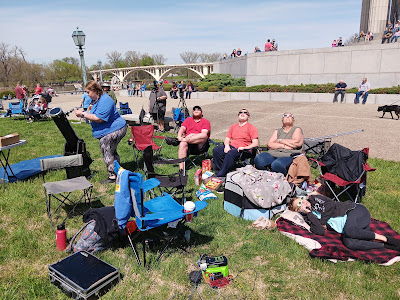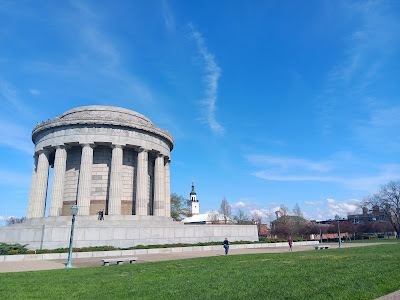The 2024 Total Solar
Eclipse
Part One- Planning
Almost
as soon as the Great American Total Solar Eclipse of August 21, 2017, was over,
I started thinking about the next total eclipse over North America. That
eclipse, April 8, 2024, would pass over much of my home state of Indiana. While
experiencing the eclipse somewhere
was more important than seeing it in Indiana, I did prioritize being in the
Hoosier State. By October 2017, I was researching observing locations in
southern Indiana, and found that the center line ran through George Rogers
Clark National Historical Park in Vincennes, right along the Wabash River. It
was also essentially the longest totality in Indiana for this eclipse. (The
center line crossed the state line slightly down river, giving a small fraction
of a second longer totality, but it looked to be private property). The
national park in Vincennes immediately went to the top of my potential
observing site list, and stayed there.
Of
course I considered other locations for the 2024 eclipse over the years; it
would have been irresponsible not to. Long range climate models showed Texas to
have the best weather prospects in the U.S. in April. Back in 2022, my best
friend Jim and I went on a baseball road trip, and saw our American Association
team from Gary, Indiana play in Cleburne, Texas, southwest of Ft. Worth. We met
so many great people, and I intend to go back some day. Cleburne was also in
the path of totality for the 2024, so it was a very tempting destination. I
even had an offer of a place to stay if I came to Texas for the eclipse.
I'm
not sure exactly when I became addicted to collecting eclipse glasses, but it
was sometime around the 2017 solar eclipse. For the 2017 TSE in Gallatin,
Tennessee, I had 16 pairs of eclipse glasses. Two of those pairs were from the
2012 Transit of Venus, while another was from a partial solar eclipse I'd seen
at Valparaiso University in 2014. But it was after the 2017 eclipse that I
truly started collecting eclipse glasses. Friends gave me theirs, and I ordered
some that were marked down after the event. I had several dozen pairs, with
around 25 unique designs. But as the 2023 annular and 2024 total eclipses
approached, I started ordering as many unique designs as I could find. I had
hundreds, and in the early months of 2024, started giving away eclipse glasses
to friends, family, co-workers, and even strangers. I even sent a box of Texas
and Indiana themed glasses to my friends in Cleburne, Texas. By the time I left
for my eclipse trip, I easily had around 80 different pairs, with maybe two
dozen extra to trade or give away. And I fully intended to pick up any that I
could along the way.
Not
long after the 2017 eclipse, I started working on a PowerPoint presentation
about the eclipse experience, both as a national event, my own experience, and
some of the science learned from the eclipse. I had worked on it for years,
adding to the presentation whenever I learned something new. The presentation
was always intended to inspire an audience to get to the path of totality in
2024. As more and more information became available about the 2024 eclipse late
last year, and into this year, I kept adding more relevant information. I
booked meeting rooms at two local libraries in March. I promoted my talk to
friends through Facebook, but since it wasn't an event put on through the
county library system, they did nothing to promote my two talks. The first hour
of my 90 minute talk was spent reviewing every aspect of the 2017 eclipse, with
the final half hour dedicated to observing the April 8 event. It was geared
towards a Northwest Indiana audience, and assumed that most would try to get to
the path of totality somewhere in Indiana. The feedback was almost all
positive, especially from first time shadow chasers after the eclipse.
Finally,
in the months leading up to the eclipse, I was following several eclipse
related groups and pages on Facebook, and reading as many articles online as I
could. I spent a couple afternoons observing the Sun, practicing how I might
try to capture the eclipse with my phone camera. And like so many others, I
spent a lot of time following the long-range weather models, especially after
April 1. I had ordered Fred Espenak's Road
Atlas of the 2024 Total Solar Eclipse, and had spent many lunch breaks
studying potential routes through Indiana and Illinois, but also Missouri,
Arkansas, and Ohio. My friend's
daughter Emily asked if she could join me on my eclipse adventure. I was
excited to have company for my trip, but Emily had to be back at work the
morning after the eclipse, so it did limit how far we could venture along the
path of totality. That was okay; I still really wanted to be somewhere in the
Hoosier State for the eclipse, and that would make getting home a little
easier.
Part Two- The Journey
Begins
The
Thursday before the eclipse I rented a Jeep to haul everything I thought I
needed for the eclipse. Working third shift, my work week ended Friday morning
at 7:00 AM. I went home, had a few last minute discussions with some of my
eclipse chasing friends, and packed the Jeep. I needed a few last minute items,
so I spent the early afternoon shopping. I also picked up my first Solar
Eclipse Slush Float from Sonic, along with the eclipse glasses that came with
it. (What a great marketing plan by Sonic. They probably paid less than $.50
per pair of eclipse glasses, and added that cost into the price of the float.
It was delicious, and seemed to be a big hit). Now all I needed was some sleep.
 |
| It's 7:00 AM Friday, and I'm ready for the adventure to begin! |
 |
| The rental Jeep. |
I woke up around my normal time of 9:30 PM. I hadn't
planned to leave until around 2:00 AM, but I knew that I wouldn't be able to
sleep again. I messaged Emily, and she was also awake and ready, so after
getting snacks and a cooler ready, I left right at midnight to pick her up. At
12:35 AM we hit the road. Our first stop was to drop off eclipse glasses to a
friend along the way, and then were off to our first destination of Terre
Haute, IN. Somehow, this must have been my first trip through Northwest
Indiana's windmill territory at night. Mile after mile, in every direction, the
red flashing lights of the windmills kept us company. We crossed the Wabash River
for the first time in the small town of Attica. The sign welcoming visitors to
Attica was too funny not to get a picture of: Welcome to Attica, "The
Place to Be." Given that Attica was outside the path of totality, it was
most definitely NOT the place to be for the eclipse.
 |
| The journey begins. |
 |
| Welcome to Attica: The Place to Be (But not on April 8) |
Before we crossed into the path of totality, a small rabbit ran into the road ahead of us, then didn't know which way to go. I somehow managed not to hit it, but it was the first of many rabbits, squirrels, birds, and deer that tried to commit suicide in front of us. Coming down U.S. 41, I knew exactly when we entered the path of totality (if not when we changed times zones). There was a small state highway that leads to Turkey Run State Park just after we entered PoT, so I pulled over on that road to take my first selfie inside the path at 5:19 AM EDT. Heading back south, it was still dark, and with the highway deserted, I could make out the stars of Scorpius right in front of me. In 2017, there was a moment on U.S. 31, halfway from South Bend to Indianapolis, that I started getting emotional, realizing that I was actually on my journey to totality. This time, that moment came when I saw Scorpius right in front of me.
 |
| Where I entered the path of totality, near Turkey Run State Park. |
 |
| Crescent Moon two days before total eclipse. |
The point of leaving two days early wasn't just to drive around Indiana and Illinois all weekend. I was scouting potential observing locations in case weather forced me to abandon Vincennes, and of course, to maybe find some eclipse glasses in each town. I knew that Terre Haute was having a downtown festival for the eclipse, but I didn't realize the festival was Monday only. The streets around town were pretty much deserted at 7:00 on a Saturday morning, but I walked around, getting a feel of the town in case I was back Monday. The Terre Haute Children's Museum had eclipse glasses available for $2, but the museum wouldn't open until 10:00 AM. I didn't want to kill three hours, so I found a local diner and ate breakfast while Emily continued to sleep in the car, then left for Vincennes.
 |
| Terre Haute Children's Museum. |
 |
| Terre Haute: birthplace of the contoured Coca-Cola bottle... |
 |
| ...but proudly serving Pepsi! I love it! |
Vincennes. I had never been there, but from the time I
passed the university, I felt like I'd known the place my entire life. I found
a parking lot right across from where the festival was set up, and headed out
to explore. It was just before 10:00AM, and festivities were just beginning. I
had ordered some Vincennes/Knox County Dark Side of the Wabash merchandise in
March, but still had to stop by their tent to check out more souvenirs. While I
was there, I heard somebody say, "You're Paulie, right?" Now, I'm
used to hearing that in American Association ballparks in the Midwest, but I
wasn't expecting it in a town that I'd never been to. I turned to see Sarah
Wolfe, director of the Vincennes/Knox County Dark Side Bash. I had commented on
many of their Facebook posts the last few weeks, so I guess it wasn't too
surprising Sarah recognized me. I took a quick picture with Sarah, then Emily
and I continued exploring the area.
 |
| Sarah Wolfe, director of the Dark Side of the Wabash festival. |
When I first found Vincennes on an eclipse map in
2017, the center line of the eclipse ran right through the George Rogers Clark
National Historical Park, along the Wabash River. Over the years, as the
eclipse parameters have been refined, the center line shifted a few hundred
feet west, to the Illinois side of the river. That was okay. The site was still
very close to the center line, and in my home state. I walked all around the
GRC monument (the largest national monument outside of Washington, D.C.), and
around the old cathedral. I didn't have any preferred location to set up in or
around the park; I just knew that this was where I really wanted to be on
Monday.
After walking around the park area, I stopped in a
coffee shop (it was going to be a long day, and caffeine was going to get me
through it). Fresh coffee in hand, we drove to the Red Skelton Museum on the
Vincennes University campus, where I was told there were VU eclipse glasses
available. To my surprise, there was even an exhibit in the museum for two
Hoosier astronauts, Virgil "Gus" Grissom, and Crown Point's very own
Jerry Ross. The eclipse glasses were complimentary, but I left a donation at
the front desk.
I didn't really have a plan for how to spend the rest
of that Saturday. I wanted to end the day in Carbondale, Illinois, crossroads
of the 2017 & 2024 total solar eclipses, but leaving early gave us enough
time to stop in Evansville first. I got my Sonic eclipse glasses Friday
afternoon in Michigan City, but Emily wanted a pair, too. We found a Sonic
halfway between Vincennes and Evansville, and stopped there for lunch. If you
didn't get the Blackout Slush Float before the eclipse (and the eclipse
glasses), I'm so sorry. You should have.
 |
| It took three tries to get this picture right... |
 |
| I found Vulcan on a solar eclipse trip. The real eclipse nerds will get it. |
 |
| Looking west to Kentucky. |
 |
| Four Freedoms monument. |
 |
| My submission to the 2045 time capsule. |
 |
| Emily painting. |
Funny anecdote: while walking around downtown
Carbondale, I heard a guy (definitely a Chicagoan) say, "I could really
live in a small town like this." Carbondale has a permanent population of
about 20,000, and has a good sized university. It also has a six lane highway
running east-west through town. A truly small town doesn't have a six lane
highway, dude.
 |
| I had to recreate these pictures from 2017, but it just wasn't the same. |
I love sleeping in hotels. I love my cats, but I sleep
so much better when I don't have to share a bed with them, or sleep in an
awkward position just so my cats are comfortable. So despite a long day, with
minimal rest before that, I was awake early Sunday morning. I went down to the
lobby for breakfast, and several other eclipse chasers were doing the same. I
asked if anybody knew where I could get local eclipse glasses, but nobody could
help me. I ate my breakfast alone, but was quietly eavesdropping on the table
of eclipse chasers next to me. It seemed like we had all seen the TSE of 2017,
but one chaser had seen the 1979 eclipse in the Pacific Northwest. Then a lady
walked in and asked, "Does anybody need glasses..."
Everybody looked at me, I shot my hand up, and
instantly knew I had made a mistake as she continued the question.
"...and a book for tomorrow?" Fuck. With
everybody looking at me and my hand already in the air, I couldn't really
refuse now. She handed me a baggie with a pair of eclipse glasses, and a couple
religious-looking books. Fuck, fuck. I'm an atheist. Oh well. I came to
Illinois looking for a pair of unique eclipse glasses, and here they were. Not
really what I was looking for, but the glasses (a cheap pair, made in China)
went in my collection. At least the glasses weren't overtly religious. When we
checked out, there were more packets of glasses/books at the front desk. Emily
somehow caught my addiction of collecting eclipse glasses, and asked me to grab
one for her and her roommate, so I did. I actually kept my own books for my
eclipse library, but I tossed the others into the dumpster we were parked next
to, lest they fall into the hands of impressionable minds, after plucking out
the glasses, of course.

Oh, jeez. The things I'll do for eclipse glasses...
We didn't have much of a plan for Sunday. My sister
and brother-in-law, Dawn and Cecil, had booked a cabin in Paoli, near French
Lick, Indiana for the eclipse, and we were going to meet them later in the day.
Back in Indiana, the first town we hit was Mt. Vernon, right on the Ohio River,
near the confluence with the Wabash. It was nearly 10:30 AM, and with time to
kill, we stopped and walked around town. Mt. Vernon is a fairly small city, and
its only events were for the eclipse the next day. We went to Riverbend Park,
where the eclipse festival would take place Monday. It was a beautiful park,
nearly completely empty except for Emily and me.
 |
| Photo credit: Emily Hampton. |
 |
| Photo credit: Emily Hampton. |
We headed back to the Jeep, and rummaged through the cooler for snacks. In all the excitement of the first day, I had totally forgot that my mom had sent her chocolate chip cookies for the trip. (If you haven't had my mom's cookies, you don't understand what a big deal this was). We devoured a few, then headed for French Lick. I stopped for gas at a truck stop north of Evansville, and went inside for coffee (I have a caffeine addiction, okay?) At the counter I saw cheap eclipse glasses, Chinese made, and possibly fake. I bought a pair anyway (this will come up again later in the day). I also got a message from Dawn that they were already in French Lick, and that she had French Lick/West Baden eclipse glasses for us.
On our way to French Lick, Emily was searching online
for things to do. She found out that the French Lick Resort had eclipse glasses
available (Dawn was able to get those for us Monday). We found a place to park
near the main square, where the small festival was happening. Dawn and Cecil
had left to check into their cabin, but were on their way back to meet us. I
checked out the festival booths and food stands until they got back. Dawn and
Cecil had been to French Lick a few times before that, and knew the town. We
visited a few shops, picked up some small souvenirs, then looked around for a
place to eat lunch.
 |
| Photo credit: Emily Hampton. |
French Lick is very proud of their most famous native
son, Hall of Fame basketball player Larry Bird. Nationally, and maybe around
the world, Indiana is known for three things: corn, auto racing, and
basketball. Fittingly, we ate lunch at 33 Brick Street, a sports bar. While we
were there, the NCAA women's national championship game was on. Even though
Iowa and basketball sensation Caitlin Clark lost the game, Clark was drafted by
the Indiana Fever of the WNBA soon after, another strong basketball tie to the
Hoosier State.
After eating, we drove over by the West Baden resort,
and then to the FLWB visitor center. The visitor center was closed, but we
walked around and took some more pictures. I made sure Dawn and Cecil got some
of my mom's cookies before they left, and then Emily and I drove back to the
French Lick Scenic Railroad station to see the trains.
 |
| Photo credit: Emily Hampton. |
 |
| Photo credit: Emily Hampton. |
 |
| Photo credit: Emily Hampton. |
It was getting late, and I needed to find a place to
stay for the night. Dawn offered to let us stay at their cabin, but I didn't
feel right intruding on their weekend getaway. I started searching for hotels
online. It took awhile, but I did find a room available, but at an inflated
rate. It wasn't too unreasonable given the circumstances. The bigger problem
was that it was all the way in Marion, Illinois, over three hours from French
Lick, and a half hour west of where we started the day in Harrisburg, IL. More
importantly, Marion is two hours and 20 minutes from Vincennes, and an hour
behind. We would have to leave around 3:00 AM to get to Vincennes by 6:30, and
I wanted to be in town getting ready for the eclipse as early as possible.

We saw a double rainbow while getting on I-64 west. Photo credit: Emily Hampton.
Around 7:15 PM (I have no idea which time zone I was
in), I stopped at the same truck stop I was at earlier to get gas, and Emily
wanted a pair of the eclipse glasses I bought there earlier. I went in, didn't
see any eclipse glasses, so I asked Addie, the girl at the counter. She said
that they sold out earlier that day, and she hadn't bought a pair yet. I asked
how many she needed, and went out to the Jeep and grabbed two of my extra pairs
for her. Nobody I met that weekend was going to be unprepared for the eclipse.
Addie took a picture with me, and then we were off to Illinois.

Addie needed eclipse glasses, and I had extra.
I mentioned earlier that late last year I had ordered
Fred Espenak's Road Atlas of the 2024
Total Solar Eclipse. It cost around $20, but what a great investment that
was. For weeks leading up to the eclipse, I spent my lunch breaks studying
potential routes I might take between various cities and towns I might visit on
my eclipse journey. The Google Maps app helped with real-time information, but
having taken notes in advance, I always knew right where I was, even though I
had never been on so many of these highways before.

Every eclipse chaser should have used this.
All weekend, almost any time we were stopped long
enough, I checked weather updates. Meteorology is hard. Weather is dynamic, and
meteorologists only have finite data points to work with. Different models come
to different conclusions based on the same data. Based on all the factors
involved, modern meteorologists do a great job forecasting weather. I
understand that. But it's no less frustrating seeing the differences between
weather models when you're trying to find the best sky possible for an eclipse.
I tried to interpret the data the best I could all weekend. But I'm not a
meteorologist. Fortunately, Sunday night I saw a video from recently retired
WGN Chicago chief meteorologist Tom Skilling. In the Chicago area, Skilling was
the best, a legend. He put out a video on social media. The only thing I really
remember from it is that Skilling had high confidence that all of Illinois and
Indiana should have only high, thin clouds at the time of the eclipse. It was
all I needed to hear. I didn't check the weather again.
 |
| Spent all weekend trying to figure out which weather models to trust. |
We were checked into the hotel in Marion by 10:00 PM,
but between getting our bags up to the third floor room, filling the Jeep at
the gas station next door, and, of course, posting my adventures of the day, it
wasn't until midnight that I laid down. I couldn't sleep. I laid there awake
for an hour, then decided I'd better take a shower, instead of waiting until I
woke up. I still couldn't sleep. My alarm was set for 2:50 AM. I'm not sure
when, or for how long, but I think I fell asleep, but was already awake when my
alarm went off.
Part Three- Eclipse Day
I woke up Emily, and started running up and down the
stairs, loading the Jeep while she got ready. As soon as I got outside, there
was a deep fog. Just my luck. (I trusted Tom Skilling, though, and didn't check
the weather). I hoped it was a local fog, but as we got out of town, it only
became worse. Luckily Illinois State Road 13 to Harrisburg was two lanes in
each direction, because I was driving 30 MPH in 45 & 50 zones. I still felt
like I was going too fast. It was hard to fight the urge to drive faster,
especially when every time I checked the GPS we had slipped another minute
behind our original estimated arrival time in Vincennes. Because of the fog, I
deviated from the route Google Maps wanted me to take, staying on roads and
highways I was more familiar with from the previous two days, and all that
studying of my atlas. The entire drive was through fog, though at least by the
time we were near Vincennes, morning twilight was starting to slowly brighten
the sky. Fortunately, GPS led me to a parking lot for the George Rogers Clark
National Historical Park that I didn't know about, and it was perfect.
We weren't the first ones there, but not many beat us
to GRC NHP that morning. Somehow, even with the fog we were there at 6:30. I
backed into a parking spot right at the south end of the park, right by the
sidewalk. With my wagon, this would make carrying all my gear much easier. The
Sun wasn't up quite yet, but I still needed to walk around and find the best
spot to set up, so I could stake my site as early as possible. Tim from North
Carolina was already out doing the same thing. We both chose spots at the edge
of the pavement south of the monument after determining that from that angle,
the Sun should be well above the trees behind us during totality. I was ready
for the Sun when it showed up between the GRC monument and the steeple of the
old cathedral.
 |
| Observation location. |
I wasn't ready to haul out all my gear yet, but I set up our chairs to mark the territory as taken. I actually don't remember too much from the morning, but it was mostly spent sending and answering messages, walking around, and drinking an iced coffee drink out of the cooler. Late in the morning, though, just before I was going to start addressing post cards I had bought in French Lick, I saw two women with postcards that were so much more awesome. Tyler Nordgren, astrophysicist, author, and artist specializes in total solar eclipse artwork, and has partnered with the national park system for years to promote solar eclipses in national parks. Well, duh. Here I was, in a national park, in the path of totality. I'd already known that Nordgren had a poster of George Rogers Clark National Historical Park, but it never occurred to me that it might be on postcards in the park gift shop. It actually never occurred to me that the park had a gift shop. But all of a sudden, I knew those were the postcards I had to send.
Back in the summer of 2017, the U.S. Postal Service
issued total solar eclipse stamps, to commemorate the upcoming eclipse. I
bought two sheets that summer. One sheet I took with me to Gallatin, Tennessee,
and mailed postcards (bought in Carbondale, Illinois, the day before the
eclipse) after totality. The second sheet of stamps I saved in my eclipse
scrapbook, and had no intention of ever using them. Ever. But why? Here was the
perfect opportunity to use them, and with totality in our home state, I'd have many
friends experiencing totality for the first time. But I also bought a regular
book of stamps, so that I could send over twice as many postcards as I did in
2017.
I went over to the gift shop, bought my postcards and
a few other things. I had a list of names and addresses, but also messaged
people that I didn't have an address for, and started writing around 10:30.
Most of the messages said something like, "I hope you have the second-best
totality!" It's a great way to kill time while waiting for the eclipse to
begin. And of course I've sent one to myself for both of my total solar
eclipses. It's a great way to re-live the experience when it arrives in the
mail.
Sometime around noon, my Aunt Janet, my cousin Patrick
and his sons Bubby, Peyton, and Austin, and my other cousin's wife Kimmy
arrived at the park. I wasn't finished with the postcards yet, but this seemed
like a good time to haul out my equipment, so I put Peyton to work helping me. I
had originally planned to set up my telescope on the pavement, but thought
better of it. My solar filter fits snuggly over the front of the telescope, but
over the years, the strip of foam rubber on the inside of the filter has worn
out a little, and I don't trust the plastic set screws that also help hold the
filter in place. If, by chance, the solar filter fell off the telescope onto
the pavement, there would be no observing the partial eclipse with it. I found
a good spot on the grass to set up instead.
In 2017, I sent my postcards after totality, but I
wasn't sure I wanted to do that this time. I wanted to see fourth contact, the
end of the eclipse, which would be at 4:20 PM. The post office closed at 5:00,
and I would most likely have to walk. I gave Emily some postcards and stamps to
send to her family, and she got hers ready. I wanted to get to the post office
and be back before first contact, but the Moon was relentless in its orbital
journey. I walked as fast as I could, but only arrived at the post office two
minutes before first contact, which was at 1:46 PM. The staff was outside with
their eclipse glasses, waiting for that first little indentation on the Sun, so
I watched first contact with them, before going inside to get the postcards
postmarked.
 |
| I watched first contact at the post office with the postal workers. |
I took a different route back to the park, and found
out the Dark Side bash was even bigger than I thought. I found more eclipse
glasses, and an eclipse trucker hat that I liked, so of course I bought them. I
also bought stickers and pins from a vendor walking through the park. By the
time I got back, it was 2:11, and the Moon had taken a nice bite out of the
Sun. I hurried to get my first picture of the eclipse.

My first image of the partial eclipse.
Obviously, at the start of the morning I was wearing a
hoodie on the chilly Hoosier morning. But it turned into a warm day by noon,
and had taken off my hoodie. Experts say the temperature can drop ten degrees
during totality, but I felt it get cooler long before totality, and put my
hoodie on again. I also noticed the quality of the light get strange about
halfway between first and second contact, which seemed earlier than I
remembered from 2017. Maybe once you've experienced totality you are more in
tune with what to expect? I don't know, but that was my observation. I did a
lot of visual observing at the telescope, but also had my phone adapter ready
to take plenty of images. I also shared the view with Emily and my family, and
of course we all were watching with our eclipse glasses. There was a family
from Wisconsin near us, and I let the kids watch as the Moon covered a sunspot.
Emily brought a straw hat, and as the Sun was just a crescent, we used her hat
to make shadow crescents on my table.
In 2017 I saw Baily's Beads ( Halley's Beads?) in my
little Coronado PST hydrogen alpha solar telescope, and it was possibly the
most vivid memory I have of that eclipse. I wanted to see it again, but this
time record them in a video. It wouldn't be quite
the same watching on my phone screen, but it would allow others to watch along
with me, and also be able to watch it over again. I had the Solar Eclipse Timer
app on my phone, and bought the timings for this eclipse ($2) on my way to the
post office. The app had a flaw in that it couldn't be used while another app
was running (um, camera?), so I didn't use it after first contact. Luckily
somebody within earshot was using the timing app (I think the Wisconsin
family), so I was able to hear warnings leading up to second contact. I was
already recording for Baily's Beads when I heard the one minute warning. I
called out to look for shadow bands, and almost immediately noticed them on the
pavement. We all saw them. That was a first for me.
Seeing the shadow bands was cool, but Baily's Beads
were what I really wanted to see, so I turned my attention back to my phone
recording the view from my telescope. As the crescent got really thin, I zoomed
in to catch those last little beads of light flickering, and then looked up,
maybe a couple seconds too early, but it was worth it. I saw Venus right away,
but there was more.
I've seen some truly excellent pictures of the diamond
rings of eclipses. None of those excellent pictures comes close to what I saw with my own
eye. I would gladly go blind to see that one more time. Totality happened fast,
at first. As soon as it went dark, I saw the streamers in the corona. During my
first totality in 2017, I was so mesmerized by the inner corona, that I never
noticed the streamers. Wow. Saturday in Evansville I'd seen some nice solar
prominences in hydrogen alpha telescopes, and wondered if we'd see any naked
eye during totality. The answer was a resounding yes. There were two gorgeous
prominences visible during the entire totality.
It was a lot to see in just a few seconds, but I had
something to do. I had stopped my Baily's Beads video and took the solar filter
off the telescope as I was looking up. But my phone was still attached to the
telescope, and I wanted to see if I could get some corona images with the
telescope. I snapped a few pictures, none great, but they did show the inner
corona and prominences. I spent a little more than half a minute on trying to
get telescopic images, and then it was time to just enjoy totality. The
telescope was still unfiltered, so I spun it around, so it wouldn't be pointed
near the Sun at third contact.

It's not a good corona image, but it's mine.
There are a few things I would have done differently
for this eclipse, but I only have one true regret. Patrick had attended one of
my eclipse talks in March, and heard me talk about trying to see the lunar
shadow approaching. He asked where I thought a good spot would be to see the
shadow coming, and I said from the GRC monument above us. In hindsight, it
wasn't much higher than where we were standing, and wasn't a very good vantage
point for seeing the shadow. But I was eager for a first-hand report of it, so
Patrick and Peyton went up to the monument. They didn't see the shadow, and
worse, lost about a precious minute of totality trying to get back to us in the
dark. The things I did wrong that affected my own experience, I can live with.
But I hate that I cost them experiencing the beginning of totality with us. I
truly regret that.

Patrick & Peyton on the monument, waiting for the lunar shadow before totality.
By my calculations (from time stamps in my photos and
video), after getting images of the corona in the telescope, I still had almost
three minutes of totality left. In Gallatin in 2017, the entire totality was
two minutes, thirty-seven seconds, so I still had plenty of time to take it in.
Actually, the four minutes, five seconds of totality in Vincennes felt like a
lifetime compared to my first experience. I saw two airplanes flying roughly
southwest to northeast, and wondered if they were two of the special eclipse
flights that Delta and Southwest (and probably others) were flying. Venus and
Jupiter were visible on either side of the eclipsed Sun, but I didn't observe
any other planets or stars (or comet). Being a wider, deeper shadow, I thought
this totality was a little darker than 2017. But eventually, the southeast sky
appeared brighter, and I started watching the Sun. I thought I noticed the red
of the chromosphere, and then, there it was, third contact diamond ring. It was
just as stunning as the first diamond ring, and then it was gone.
 |
| Streamers and Venus are visible. |
Wow. I'm overcome with emotion just writing about it
again now. I took a moment to take it all in, and then remembered to put the
solar filter back on the telescope. There was still an hour and ten minutes
until fourth contact, and I intended to observe until the end. But unlike the
totality that seemed to last a lifetime, from third to fourth contact seemed to
fly by faster than the planes I'd seen during totality. I had over 80 pairs of
eclipse glasses, but had only used my Vincennes/Knox County glasses, and an
Indiana pair I'd ordered from, of all places, Totality Over Texas. Now that
there was no pressure, I hurriedly went through each pair, just long enough to
say I'd seen this eclipse with them, but didn't take pictures of each pair.
After totality, the crowd gradually thinned out. I
heard one of the park rangers tell somebody that they have a similar sized
crowd every year for Independence Day fireworks, and the next day the
two-person grounds crew spends the day cleaning the park. Today the park looked
immaculate; not a single piece of trash on the ground. And later, as I was
leaving town, there was no indication that there had been a crowd of 30,000
people gathered. Great job not only to the workers cleaning up, but all the
visitors for being great guests.
As fourth contact approached, I began taking images at
the telescope again. I wanted to document the very end of the eclipse. Again, I
could hear the eclipse timer app in the background somewhere, and took my final
image as it called fourth contact at 4:21:01 (the event booklet from
Vincennes/Knox County listed fourth contact at 4:20). My aunt and cousins left
soon after, but I was in no hurry to get on the road. I packed up, and went
back to the gift shop, but there were no shirts I liked that would fit me. I
wandered around the park, still overjoyed at the experience. Most of the crowd
was gone, but there were still some people lingering around the park and
monument, like they would on any other beautiful spring day in Vincennes. But
this was no ordinary day in Vincennes: it will be long remembered as "The
Day the Sun Went Dark."
 |
| Fourth contact. The eclipse is over. |
Tim from North Carolina was one who had lingered
around, and we took a picture together. He was one of the few people at the
park before me that day, and we had bounced ideas around and shared views in
cameras and telescopes all day. Tim was a cool guy, and I'm glad our paths
crossed for this eclipse.
We left the park around 5:15, but I stopped at the
Indiana Military Museum just down the street. I got out and took some pictures
from the parking lot, and Emily and I each called our families back home to
tell them about the experience. Then we drove downtown. The main library was
decorated for the eclipse, so we had to stop and take more pictures. I hadn't
really eaten since lunch the day before, so we had to find someplace to eat. We
went to Culver's, and I felt bad that we weren't going to a local restaurant
until I saw they were an official sponsor of the Dark Side of the Wabash.
 |
| Culver's was a sponsor of Dark Side of the Wabash. |
Even as we were eating, I saw a now infamous picture
of traffic on I-65 north of Lafayette. I had no intention of taking 65, so I
wasn't concerned. U.S. 41 had little to no traffic between Vincennes and Terre
Haute, and even for awhile north of Terre Haute. We were pointing out road side
attractions, as we'd done all weekend. It was almost a running joke as either
Emily or I pointed out every Dollar General store or Hauk's Supermarket we
passed.
Obviously, Vincennes had a great eclipse experience,
and from what I'd seen from friends, it looked like all of Indiana had a
near-perfect eclipse day. One more thing could make this one of the greatest
days in Indiana history, only this event wasn't taking place in Indiana. Purdue
University had advanced to the NCAA's men's basketball championship game in
Arizona. (Earlier in the day, Purdue had partnered with NASA and Indianapolis
Motor Speedway to host the largest eclipse event in the country). A national
championship would make this state go crazy. Emily flipped through stations until
she found the game on the radio, and watched coverage on her phone while I
drove. It was apparent almost from the start that Purdue was overmatched, and
eventually I tuned the game out of my head and concentrated on driving.
After stopping for gas and coffee, we eventually ran
into traffic on U.S. 41. It wasn't too bad, but people were driving too fast
for the congestion, so I detoured onto back roads. We were still at least two
hours from home, but back in my days of working insulation, I'd driven all over
northern Indiana, and knew plenty of back roads. Others soon got the idea, as
were within sight of the gridlock on I-65 to the right. I zigzagged along
county roads, trying to avoid as much traffic as I could, trying to get east of
the interstate highway. I figured Chicago-bound traffic would try to stay west
of 65. It wasn't until we crossed into Porter County that we truly lost all the
traffic. It ended up taking about six hours for what should have been a four
hour drive, but it never felt like a traffic nightmare, like I experienced in
Kentucky after the 2017 eclipse. I dropped off Emily around 11:30, and was home
to my cats by midnight. I even had time to stop and pick up the eclipse
editions of the local newspapers.
April 8, 2024 was now history. I'd waited for this day
for more than six and a half years. I'd tried to convince anybody who would
listen that they should get into the path of totality for this eclipse. Many
people I know did, and some of them even did it because of my hype. For
everybody that was in the path of totality, I hope your experience was as good
as mine. For me, the eclipse was everything I'd hoped for. I saw shadow bands.
I saw and recorded Baily's Beads. I saw the both diamond rings. I saw the
corona and streamers. I saw planets and prominences. I got to share it all with
family. I drove a lot of miles, and visited places in my home state I'd never
been to. And I met some wonderful people along the way. I was somehow both
under-prepared and over-prepared for this trip. But when the lunar shadow came,
I was right where I had wanted to be all along. I'll see you in the shadow
again someday.

I'll see you in the shadow again, someday, somewhere.










